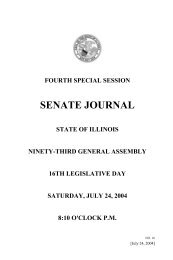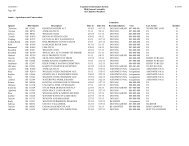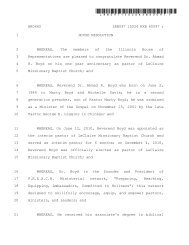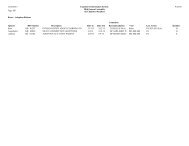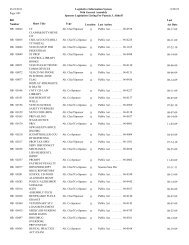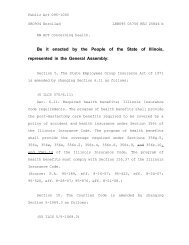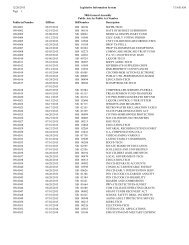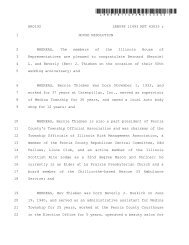Long-Term Care - Illinois General Assembly
Long-Term Care - Illinois General Assembly
Long-Term Care - Illinois General Assembly
Create successful ePaper yourself
Turn your PDF publications into a flip-book with our unique Google optimized e-Paper software.
Additionally, it is far more cost effective to revitalize existing nursing homes than construct new<br />
ones from scratch. Effective financing and bonding approaches can aid existing facilities to<br />
upgrade for modern technology, resident centered equipment, and solar panels and other<br />
heating efficiencies.<br />
Nursing homes promote resident-centered care, meeting the specific needs of each individual<br />
resident. This theme is the hallmark of the Pioneer Movement: designing programs to give<br />
residents more day-to-day choices in their life routines, and empower front-line staff to make<br />
more care decisions for the residents they serve. Across the nation, nursing home providers<br />
are looking beyond the traditional nursing home model to develop new and innovative ways to<br />
meet each resident's individual care needs. The kind of management and staffing changes<br />
these programs require, however, are often beyond the means of Medicaid nursing homes. The<br />
state should sponsor an incentive program for those progressive Medicaid facilities willing to<br />
invest in innovative, non-traditional approaches to care.<br />
Besides promoting innovation, the state can better meet residents' specific health care needs by<br />
certifying nursing facilities based on their specialties. Categories for certification include<br />
Alzheimer's disease, stroke, cardiac care, diabetes, skin care and many others. These<br />
certifications would help consumers make better nursing home choices, selecting nursing<br />
facilities that have the most expertise in the treatment of specific medical conditions.<br />
The state could also help consumers make sound health care decisions by developing resident<br />
and family customer satisfaction surveys, sharing these results with the public through the<br />
Internet or by publishing an IDPH consumer guide on choosing a nursing home. These<br />
materials should emphasize 3 key areas: the restorative and rehabilitation services that each<br />
nursing home provides; the medical specialties of each facility; and the customer satisfaction<br />
levels of the individuals served by each home.<br />
This emphasis on care delivery and outcomes should carry over to the state's survey<br />
enforcement system as well. The state should focus its system on the results of the care<br />
residents receive, with less emphasis on the hundreds of current survey items that have no<br />
impact on resident well-being.<br />
3 key areas for change:<br />
• Create quality staff for quality care.<br />
• Develop smaller and more specialized facilities in a continuum of community based care.<br />
• Refocus on resident-centered care within the context of cost accountability.<br />
Related recommendations for short and long-term changes:<br />
• The <strong>Illinois</strong> nursing home system should be dramatically transformed and strengthened.<br />
• A 5.9% rate cut last year, no increases this year, skyrocketing staff and liability costs,<br />
and erratic and unpredictable payments from the state have all created a crisis<br />
atmosphere where some facilities will not survive. <strong>Illinois</strong> needs to stabilize Medicaid<br />
payments and restore the 5.9% Medicaid rate cut made in July 2002, with future<br />
Medicaid reimbursement reflective of the continuing cost of caring for an increasingly<br />
fragile population.<br />
78




